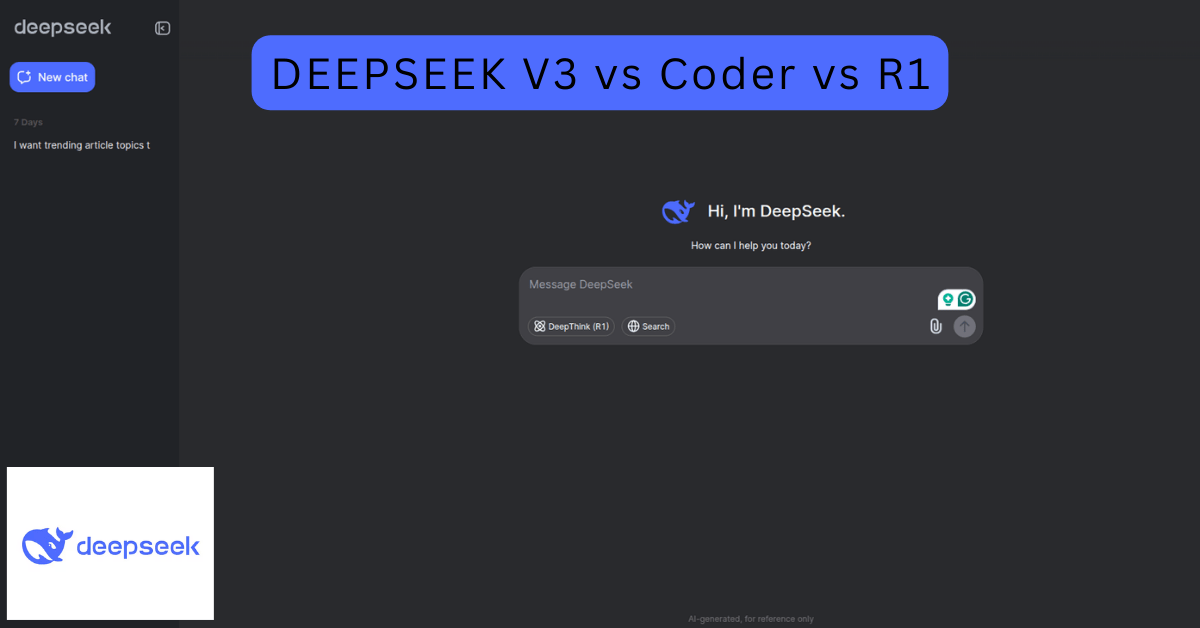DeepSeek V3 vs. R1 vs. Coder: Key Differences & Best Uses

Artificial intelligence is transforming the way we approach coding, problem-solving, and logical reasoning. DeepSeek offers three specialized models—V3, Coder, and R1—each designed for a specific purpose. This guide will help you understand their differences and determine which one suits your needs best.
Key Takeaways
- DeepSeek V3: A multi-functional AI excelling in coding, mathematics, and multilingual tasks.
- DeepSeek Coder: A code-focused AI for programming assistance and debugging.
- DeepSeek R1: A reasoning-oriented AI optimized for logic, problem-solving, and verification.
- All models are open-source, making them accessible for various applications.
Overview of DeepSeek Models
DeepSeek V3: The Versatile AI
Purpose: A powerful AI model designed for diverse tasks across multiple domains.
Strengths:
- Excels in multilingual processing, coding, and mathematical tasks.
- Utilizes a Mixture-of-Experts (MoE) system with 671 billion parameters (37 billion active per token).
Best For: Organizations and researchers seeking a flexible AI for diverse tasks.
Example Use Cases
Scenario 1: A multinational e-learning platform needs an AI to generate course content, translate lessons, and provide coding exercises. DeepSeek V3 streamlines content creation, ensures linguistic accuracy, and assists students with programming exercises.
Scenario 2: A business analytics firm uses DeepSeek V3 to summarize financial reports in multiple languages while also analyzing trends in numerical data.
DeepSeek Coder: The AI for Developers
Purpose: A model specialized in code generation and software development.
Strengths:
- Trained on 87% programming data, making it highly effective for coding.
- Offers parameter sizes from 1.3 billion to 33 billion.
Best For: Software engineers, coding assistants, and development platforms.
Example Use Cases
Scenario 1: A developer is implementing a Python function to check if a given number is prime. DeepSeek Coder suggests the following optimized solution:
def is_prime(n):
if n < 2:
return False
for i in range(2, int(n ** 0.5) + 1):
if n % i == 0:
return False
return True
It also provides alternative approaches and debugging tips, making development more efficient.
Scenario 2: A software engineer encounters a bug in their JavaScript code where a loop isn’t terminating correctly. DeepSeek Coder analyzes the logic and suggests:
for (let i = 0; i < arr.length; i++) {
if (arr[i] === target) {
console.log("Found target at index", i);
break; // Ensures loop stops after finding the target
}
}
This helps streamline debugging and improve code efficiency.
DeepSeek R1: The Logical Thinker
Purpose: A reasoning-focused AI for problem-solving and self-verification.
Strengths:
- Trained to analyze and verify logical processes.
- Available in parameter sizes ranging from 1.5 billion to 70 billion.
Best For: Educational platforms, research institutions, and advanced problem-solving tasks.
Example Use Cases
Scenario 1: A student asks an AI tutor to solve a logic puzzle: “If Alice is older than Bob and Bob is older than Charlie, who is the youngest?”
DeepSeek R1 breaks it down:
- Given: Alice > Bob, Bob > Charlie.
- By transitive property: Alice > Bob > Charlie.
- Conclusion: Charlie is the youngest.
- Verification: Checking the conditions confirms the logic is correct.
Scenario 2: A physics student asks an AI tutor to solve an equation: If a car travels 120 miles in 3 hours, what is its speed?
DeepSeek R1 breaks it down:
- Distance = 120 miles, Time = 3 hours.
- Speed formula: Speed = Distance / Time.
- Speed = 120 / 3 = 40 mph.
- Verification: Checking the calculation confirms accuracy.
This structured reasoning helps students grasp concepts effectively.
Core Differences
| Feature | DeepSeek V3 | DeepSeek Coder | DeepSeek R1 |
|---|---|---|---|
| Primary Use | Multi-purpose AI | Programming & code generation | Logical reasoning & verification |
| Training Data | Mixed (coding, languages, mathematics) | 87% code-based training | Reinforcement learning for logic |
| Architecture | Mixture-of-Experts (MoE) | Transformer-based | RL-optimized |
| Use Cases | AI research, multilingual support | IDE tools, code assistance | Problem-solving & education |
| Open Source | Yes | Yes | Yes |
| Parameter Range | 671B (37B active per token) | 1.3B to 33B | 1.5B to 70B |
Choosing the Right Model
- DeepSeek V3 → Best for versatile applications in multiple fields.
- DeepSeek Coder → Ideal for programmers and software development tools.
- DeepSeek R1 → Perfect for logical reasoning and education.
Performance Comparison
| Task Type | Best Model | Why? |
|---|---|---|
| Language Translation | DeepSeek V3 | Strong multilingual capabilities |
| Coding & Debugging | DeepSeek Coder | Specialized in code generation |
| Mathematics & Reasoning | DeepSeek R1 | Reinforcement learning ensures accuracy |
| General AI Tasks | DeepSeek V3 | Adaptable to multiple domains |
| Education & Tutoring | DeepSeek R1 | Logical step-by-step reasoning |
How to Start Using DeepSeek Models
- Get Access: All models are open-source and available on GitHub.
- Install Locally: If you want to run DeepSeek models on your own hardware, follow this step-by-step guide: Install DeepSeek Locally.
- For the Official chat dashboard – https://chat.deepseek.com/
- Integrate with Your System: Use API calls or backend implementations for seamless use.
- Fine-Tune for Specific Needs: Custom training helps improve model performance for specialized tasks.
Final Thoughts
DeepSeek’s AI models cater to a wide range of users:
- V3 for flexible, multi-purpose applications.
- Coder for efficient programming assistance.
- R1 for logic-driven problem-solving and education.
With open-source accessibility, these models empower developers, researchers, and educators to build smarter solutions for various industries.
Since DeepSeek V3, Coder, and R1 are open-source models, you can find more details and official resources on their respective repositories or documentation pages.
Here are some reference links to explore:
- DeepSeek AI Official Website: https://www.deepseek.com
- DeepSeek on GitHub: https://github.com/deepseek-ai
- DeepSeek V3 Documentation: https://github.com/deepseek-ai/DeepSeek-V3
- DeepSeek Coder Documentation: https://github.com/deepseek-ai/DeepSeek-Coder
- DeepSeek R1 Documentation: https://github.com/deepseek-ai/DeepSeek-R1